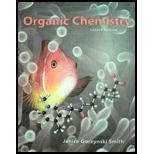
Concept explainers
(a)
Interpretation: The shorter bond in the given compound is to be identified.
Concept introduction: An increase in percent
(b)
Interpretation: The shorter bond in the given compound is to be identified.
Concept introduction: An increase in percent
(c)
Interpretation: The shorter bond in the given pair of compounds is to be identified.
Concept introduction: An increase in percent
(d)
Interpretation: The shorter bond in the given pair of compounds is to be identified.
Concept introduction: An increase in percent
Want to see the full answer?
Check out a sample textbook solution
Chapter 1 Solutions
Organic Chemistry - With Access (Custom)
- Which resonance structure contributes the most to the resonance hybrid?arrow_forwardThe steroid stanolone is an androgenic steroid (a steroid that develops or maintains certain male sexual characteristics). It is derived from testosterone by adding a molecule of hydrogen across the C=C bond in testosterone. Using Figure 7.39c as a guide, draw the molecular structure of stanolone. What is the molecular formula of stanolone?arrow_forwardIn HF , neither H nor F holds a full formal charge of +1 or 1 . Organic chemists represent apartial charge using the Greek letter delta () . On the electron density map of the molecule HF above, add a + to one atom and a to the other to indicate which way the bond is polarized.arrow_forward
- A. Draw the meantime r of ephedrine. You can use line structures or a hybrid line structure/condense drawing like the one shown. Be sure it is clear which bonds are wedge and which are dash. B. Draw a diastereomer of ephedrine.arrow_forwardWhats the name of step and 1 and drar mechanksm arrows even showing electrons on oxygen atomsarrow_forwardWith the given compounds, what is the most stable or with highest polarity?arrow_forward
- how to draw at least one or two structures from the molecular formula after calculating DU?arrow_forward(a) Add curved arrows to show how the starting material A is converted to the product B. (b) Draw all reasonable resonance structures for B. (c) Draw the resonance hybrid for B.arrow_forwardDraw all of the constitutional isomers of Octane. Name each one. For each isomer:arrow_forward
- For which compounds can a second resonance structure be drawn?Draw an additional resonance structure and the hybrid for eachresonance-stabilized compound.arrow_forwardAnswer the three questions for the given structures a.), b.), and c.)arrow_forwardDraw a second resonance structure and the hybrid for each species, and then rank the two resonance structures and the hybrid in order of increasing stability.arrow_forward
 World of Chemistry, 3rd editionChemistryISBN:9781133109655Author:Steven S. Zumdahl, Susan L. Zumdahl, Donald J. DeCostePublisher:Brooks / Cole / Cengage Learning
World of Chemistry, 3rd editionChemistryISBN:9781133109655Author:Steven S. Zumdahl, Susan L. Zumdahl, Donald J. DeCostePublisher:Brooks / Cole / Cengage Learning Organic Chemistry: A Guided InquiryChemistryISBN:9780618974122Author:Andrei StraumanisPublisher:Cengage Learning
Organic Chemistry: A Guided InquiryChemistryISBN:9780618974122Author:Andrei StraumanisPublisher:Cengage Learning Principles of Modern ChemistryChemistryISBN:9781305079113Author:David W. Oxtoby, H. Pat Gillis, Laurie J. ButlerPublisher:Cengage Learning
Principles of Modern ChemistryChemistryISBN:9781305079113Author:David W. Oxtoby, H. Pat Gillis, Laurie J. ButlerPublisher:Cengage Learning


